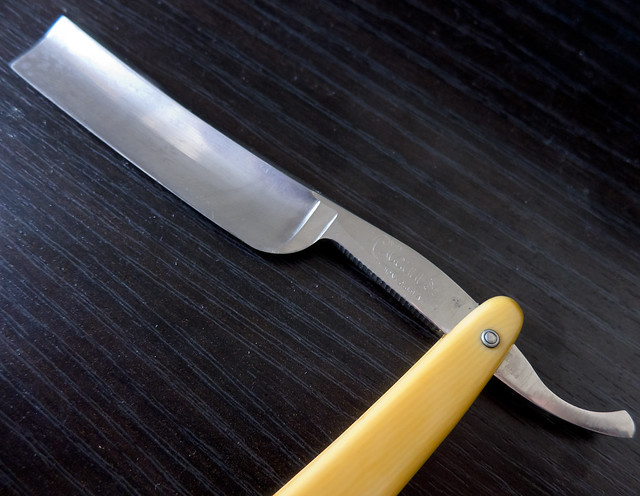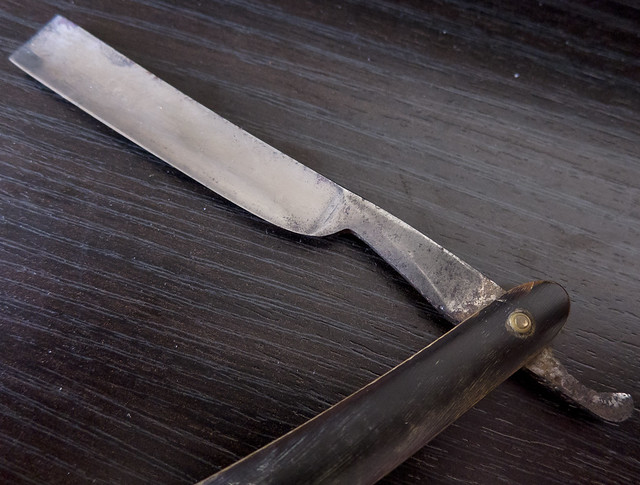Results 1 to 7 of 7
Thread: Newbie with a pile of razors.
Threaded View
-
05-22-2011, 10:53 PM #1
 Newbie with a pile of razors.
Newbie with a pile of razors.
I've introduced myself over in the Clubs thread with pictures of my Clauss Art Nouveau razor.
Quick recap: I'm a raw newbie, I want to learn restoration and honing.
More importantly, pictures!

Razor Pile - 2011-05-22 by Zak Jarvis, on Flickr
From left to right:
Nameless and unmarked; Joseph Rodgers (marked 'Cutlers to Their Majesties, Sheffield, no England stamp -thus probably Victorian); Campbell MFG Co (Chicago); Cosmo MFG (Germany); Hackett, Walther, Gates Hardware Co. (St. Paul, MINN); Salamander Wedge (Foche - Solingen); Clauss (Fremont, OH); scaleless F.W. Engels LEADER (Solingen).
I've got one more on its way to me, a 1820-1830 era Wade & Butcher.
Of the ones I have at the moment, here are my favorites (this will likely change once I'm actually USING them, but there's a good deal of work before I get there).

Joseph Rodgers by Zak Jarvis, on Flickr
This Joseph Rodgers blade just feels good in hand. It's solid. Weighty but not heavy. The spine is hollow, the single shoulder is attractive. It was an eBay special and the celluloid scales have 'R. G. Hodge 1910' scrawled into them. There's a chip out of the scale about a quarter inch above the pivot pin. I'll probably completely rescale it (though, if possible I'll preserve the original because of the scrawl -- I find that kind of personal touch endearing). Mostly I'll rescale it because I just don't like celluloid. It smells bad and it doesn't feel particularly great in hand, either.

Clauss by Zak Jarvis, on Flickr
I paid a goodly premium for this on eBay because it was in really nice shape to begin with and it came with the original, fancy presentation box. It's about the same size as the Joseph Rodgers, but with a more hollow grind (I'd estimate it is half hollow vs quarter hollow, but see above about raw newbie), so it's lighter. I grew up in a house full of Nouveau prints (Mucha, Parrish, etc), so I'm somewhat predisposed to the style. The inlay on the handle is silver with enamel painted lily-of-the-valley. There's a very small imperfection in the inlay, some spots on the blade but this one is otherwise very clean. After poring over it with a jewelers loupe, my guess is that someone bought this when it was new, used it until it wasn't sharp, then put it away forever in an air-tight vault. I seriously don't think it's been honed since it was purchased. I'm pretty sure the scales are bakelite.

Nameless by Zak Jarvis, on Flickr
Completely unlike any of the others. It's totally unmarked. The scales are horn and in decent shape (very good if I'm right on the age of this). It's about halfway between a 4/8 and 5/8. It feels small. Going by the chart over here I'm guessing it was made somewhere between 1810 and 1845. Without marks though, who knows? The tail is extremely pitted. Lunar, even, but the blade is relatively clean. There's a very slight curve in the spine just before the blade, but it is otherwise straight. It lays perfectly flat. This one fascinates me because it's so unknowable. Also, of all the razors I've gotten, this one is the only one that was sharp enough on purchase to cut hair on my arm. I'm going to try to preserve the scales if at all possible.
Of all these I've only cleaned up and/or worked on a very few. I've cleaned the Salamander, The Hackett, Walther, Gates and the F.W. Engels. The Engels came with scales, but they fell apart when I unpinned it (and had been poorly glued before that). I've been playing with using vinegar to restore the darkened etching on the blade of the Hackett, Walther, Gates (it seemed like a great blade to practice on since it's no great loss if I wreck it, but it'll be pretty neat if I can fix it) and the tang of the Engels.
I'm sending at least two off for professional honing, I just haven't decided which yet.
Currently I'm leaning toward sending the Clauss and the Salamander for honing. The Salamander because it's a near-full wedge, the Clauss because it's so nice I don't want to hurt it.
I'll keep updating here as I work on things, but this seems like a good place to start.


 LinkBack URL
LinkBack URL About LinkBacks
About LinkBacks







 Reply With Quote
Reply With Quote